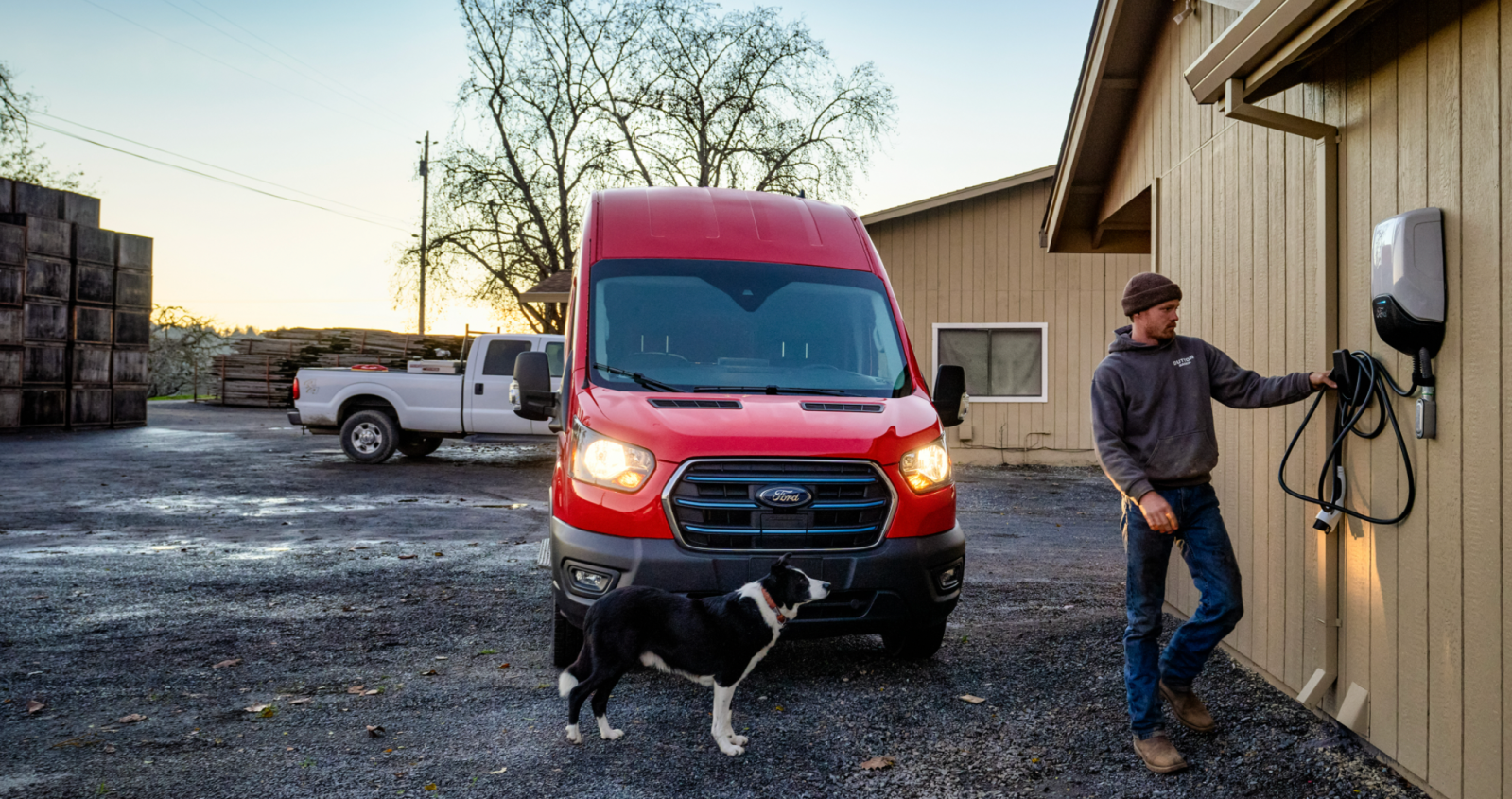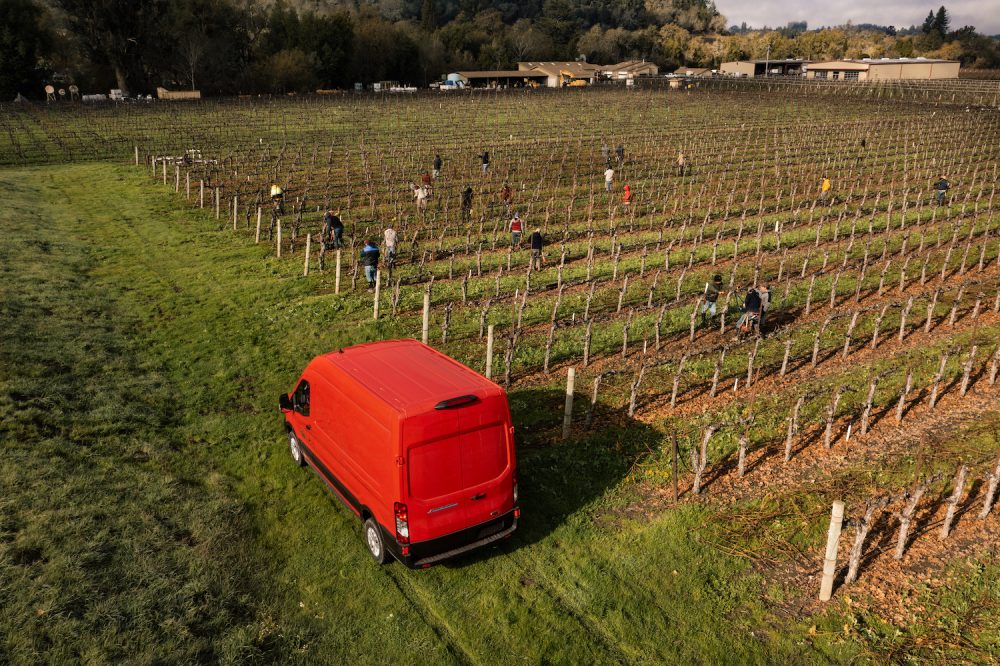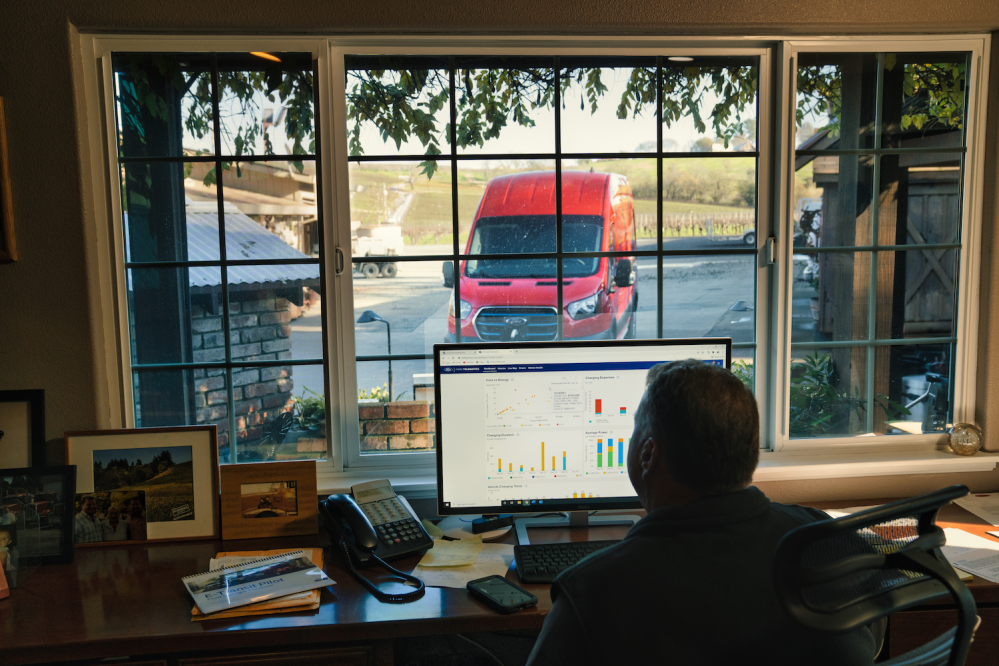
- Ford’s versatile E-Transit 126-mile electric sprinter/cargo/van platform began production from its Kansas City, Missouri plant. Deliveries begin in a few weeks. I drove it, but drive impressions have to wait.
- Ford is super high on its own supply of Telematics software but equally high on its new Salesforce partnership for software and services.
- I came to California to drive a Ford F-150 Lightning and I got two awesome days in Sonoma meeting Francis Ford Coppola, chatting with some great Ford engineers/execs, drinking some amazing wine, and driving an electric sprinter van (not in that order).
We learned a lot this week as Ford flew us out to Sonoma, CA, and took us to some winery businesses that would soon be using not only electric Ford Pro vehicles but would also be using its telematics software stack to manage everything about them.
Ford E-Transit launch
We had some great behind the wheel time in the Ford E-Transit, in both high and low top configurations. The first E-Transits are rolling off the assembly line in Kansas City now and will be in drivers’ hands in the next few weeks.
The RWD vehicle driving experience, with its base model Mustang Mach-E battery and 198 kW/266 HP drivetrain was…not very Mustang-like. We’ll have more drive impressions later along with a video when the embargo lifts.
At $43,295 to $52,690, the E-Transit is fairly competitively priced with other Sprinter vans – especially considering the significantly lower cost of ownership (electric cheaper than gas, less maintenance) that EVs almost always provide. Ford says fleet managers have been chomping on the bit for electric transit options, with one even quoted as saying he needed electric versions to “help me not get fired.”
Here are the various E-Transit configurations and prices:
| Body Type | Roof Height/ Wheelbase | Targeted Battery Range (miles) | Targeted starting MSRP under |
| Cargo Van | Low Roof (83.6″)/ Regular (130″) | 126 | $47,185 |
| Cargo Van | Low Roof (83.6″)/ Long (148″) | 126 | $48,395 |
| Cargo Van | Medium Roof (100.8″)/ Regular (130″) | 116 | $48,280 |
| Cargo Van | Medium Roof (100.8″)/ Long (148″) | 116 | $49,490 |
| Cargo Van | High Roof (110.1″)/ Long (148″) | 108 | $51,530 |
| Cargo Van | High Roof (110.1″)/ Extended (148″) | 108 | $52,690 |
| Chassis Cab | Low Roof (83.6″)/ Extended (178″) | N/A | $43,825 |
| Cutaway | Low Roof (83.6″)/ Extended (178″) | N/A | $43,295 |
Since the E-Transit was announced back in November 2020, the big knock on it has been the 126-mile range. To get this thing to market quicker, Ford basically just affixed a Mustang Mach-E Battery and motor to the bottom of its Transit frame. But all that added size and weight reduces the Mustang Mach-E range from around 300 miles down to 126 in the E-Transit, and that’s for the lower roof model in normal driving conditions. That means the higher roof models in the winter are going to have significantly lower than a 100-mile range.

Charging is also respectable, but not what I’d call revolutionary. E-Transit is going to be able to DC fast-charge at over 115 kW, but like every other vehicle, it is more about the charge curve, which we don’t yet have. The automaker believes that it adds “approximately 45 miles of range in 15 minutes.” Most of these vehicles will be charged at night on level 2 chargers, where they can go from empty to full in under 10 hours.
Still, Ford notes that fleet managers don’t have the same “emotional” range anxiety consumers have. Most fleet vehicles drive under 70 miles a day. Those miles are also much more predictable with less variance than consumer use cases, and let’s just say that Ford’s E-Transit order book isn’t lacking.
That means this version of the E-Transit addresses about half of the Ford Transit market.
The very well PR-trained engineers all had the “we have no larger sized battery options to announce, but look at all that room around the current battery! **wink wink**” refrain. A bigger battery option is coming, but Ford doesn’t want fleet owners to wait or think there are more options to consider here, at least not yet.
I wondered if someone who bought a 126-mile E-Transit could expect Ford to offer them a battery upgrade path later since the battery is just (securely) hung below the frame. No one could commit to that, but it is something that Ford would consider. One point of view I heard that makes a lot of sense was that it would just be easier to trade in your 126-mile E-Transit for a larger battery one in the future like you did your iPhone when a better one came out. There is no sentimentality in the fleet space!
My E-Transit dream? A double-sized battery, 250-mile range, with double the speed of charging (230kW) that could be converted into the perfect small E-RV. Think about a little 2kW solar roof that you could live in for weeks or months off grid!
Ford Pro Telematics with Salesforce

Ford announced its telematics software built on Salesforce in December, but this is the first time we’ve seen it in action on real farms.
The news here:
- Collaboration will supply three pilot program farms in Sonoma County, California, with the full suite of Ford Pro™ solutions, including F-150 Lightning™ Pro pickups and E-Transit™ cargo vans to help drive their business forward while tackling the next frontier in sustainable fleet operations.
- Pilot program farms are being outfitted with Ford Pro™ Charging stations to complement the solar power that has been a critical part of the Sonoma County Winegrowers’ collective push for 100% sustainability since 2014
- Ford Pro™ Intelligence™ services designed to help small-businesses optimize gas and electric fleets by providing always-on access to vehicle health reports and other data that helps lower operating costs, vehicle downtime, and fuel consumption
Telematics is going to be a big business at Ford, with CEO Jim Farley estimating that the SaaS and repair business will be up to half of Ford’s profits by the end of the decade.
The move to electric vehicles is part of why the Telematics is important. Fleet owners and drivers know they need to go to electric but are untrained in how to manage electric fleets.
Ford’s telematics, which we got a few working examples to see, allows fleet operators to see where their vehicles are, knowledge of the vehicle including state of charge, and manages costs of charging and charging centers. It really is a complete fleet management tool built on top of Salesforce.
Salesforce CEO Marc Benioff was at the event this week and also talked about how he loved his two Mach-E’s more than any other EV, including his Tesla. But Ford was also dangling Ford F-150 Lightning early access in front of all these people, so I’m going to take all of these statements with a grain of salt.
Probably the most interesting use case was at the Dutton farm, where we got to see the Telematics in action, finding a driver named Juan who was driving a Ford E-Transit. We could see his current location, state of charge, the state of the vehicle, and also his driving history for the day on a map.
“Ford Pro is thrilled to team with the Sonoma County Winegrowers to further their sustainability goals and begin their transition to fully integrated all-electric fleets with on-site charging,” said Wanda Young, Ford Pro global chief marketing officer. “Ford Pro and the Sonoma County Winegrowers are driven by many of the same tenets – to accelerate productivity while operating responsibly.” The pilot program is launching with Bevill Vineyard Management and Vino Farms in Healdsburg, and Dutton Ranch in Sebastopol – which collectively represent about 4,000 acres in the vineyard-rich Russian River Valley. Young anticipates the program will expand in the coming months to include other farming operations in the county.
Perhaps most interesting is that Ford’s Telematics can also work on recent Ford ICE vehicles with modems and even vehicles of other makes with an adapter.
Ford F-150 Lightning Pro first ride
We finally got our first drive in the Ford F-150 Lightning Pro, which is set to begin deliveries in the Spring. That’s the one that starts under $40,000 before incentives and has that black plastic front end vs. the more familiar painted front end in the consumer models. The center screen is also a more traditional smaller landscape layout vs. the more consumer big vertical screen with a big glued-on volume control knob.
I’ll be honest, it wasn’t as exciting as I’d hoped or even our earlier rides at the Ford proving grounds. We jaunted around the Dutton Vineyard discussing roles of the pickups and other work vehicles and how Ford’s F-150 Lightning would do those jobs even better. I was hoping for some behind-the-wheel time, but my understanding is that Ford’s policy is that pre-production vehicles can only be driven by engineers. My policy is to give that policy a big thumbs down. However, by the way, the vineyard owners were excited about the vehicles, you’d think (again **wink wink**) they had some behind the wheel time.
Electrek’s take
It is easy to fault the legacy American carmakers for being slow to adopt EVs. However, under CEO Jim Farley, Ford is not only talking the talk, but with the launch of the E-Transit, walking the walk. The F-150 Lightning has exploded with popularity, and impressive orders have Ford doubling, again and again, its ramp up.
These vehicles are a good first step, but I’m still not totally convinced Ford realizes how fast it has to change. CEO Farley still sees a big ICE mix in 2030.
I think Ford should prepare for an all electric future, coming a lot sooner than anyone seems to think.
FTC: We use income earning auto affiliate links. More.




Comments